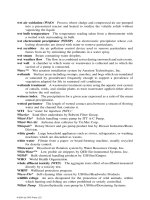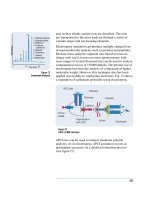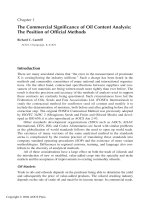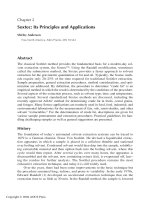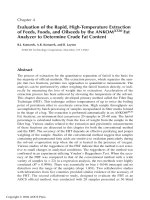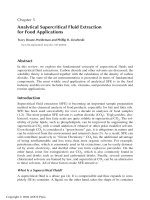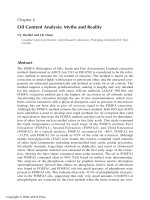oil extraction and analysis phần 9 pps
Bạn đang xem bản rút gọn của tài liệu. Xem và tải ngay bản đầy đủ của tài liệu tại đây (600.21 KB, 14 trang )
Chapter 9
Simple Methods for Measuring Total Oil Content
by Benchtop NMR
P.H. Krygsman and A.E. Barrett
Bruker Optics Ltd., Minispec Division, 555 Steeles Ave., East Milton, Ontario L9T 1Y6,
Canada
Abstract
Low-resolution time domain nuclear magnetic resonance (TD-NMR) is an interna-
tionally recognized and commercially important analytical tool for measuring the
oil content in oilseeds and oilseed residues. It is commonly employed as a simulta-
neous determination of oil and moisture content, as in ISO 10565 or AOCS Ak 4-
95. Because the method is very fast, compared with oven drying to determine
moisture and extraction to determine oil, rapid and more frequent testing is possi-
ble, and dry-weight oil is easily reported. The NMR method is widely used in
European countries, especially France and Germany, for oil in sunflower, rape, and
soybean. A related method used in Spain is oil in olives for assigning commercial
value. In North America and South America, official oil content in canola and sun-
flower is determined by the NMR method. All other oilseeds are amenable to the
method, including soy, flax, corn, cotton, and peanut. A large part of the reason for
the success of the method is the simplicity of calibration. In cases in which rapid
and accurate screening of oil content is the primary concern, simple calibration
maintenance is desired. Calibration for oil can involve as few as two or three refer-
ence oilseed samples. Often 5–20 calibration samples are used to satisfy statistical
variation in the natural product. Repeatability of measurement is usually limited by
subsampling error. If the same sample is measured repeatedly, the SD is typically
≤0.02. Agreement between duplicate samples taken from the same lot depends on
the oilseed and size of sample used. It was found to be ~0.1–0.2 for soybean mea-
sured in ~22-g samples. TD-NMR measures oil by detecting the hydrogen in the
liquid phase of the sample. The NMR signal for oil is well isolated and normally
free of interference from other components of the oilseed; under normal condi-
tions, the signal per gram increases in a simply linear fashion with increasing oil
content. Moisture present in the seed <10% by weight (14% in soy) is strongly
associated with solid components, and relaxes at least an order of magnitude faster
than oil. If excess water is present in the sample, it must be removed by a predry-
ing step. Water in various degrees of “free” states may relax with a time constant
similar to that of oil, or even longer. Vegetable oils contain a mixture of fatty acids
Copyright © 2004 AOCS Press
in triacylglycerides, and the fatty acid profile can vary considerably. If unsaturation
is introduced, the hydrogen content (%) decreases. This decrease also will result in
a lower estimate of total oil content because hydrogen is used as a reporter in the
NMR measurement. The hydrogen content (%) can easily be determined in isolated
oil (extracted or expressed) to ensure that it fits within an acceptable range.
Introduction
Oilseed characterization naturally requires measurement of total oil content.
Traditionally, this involved solvent extraction, but many have been motivated by
concern over safety and the need for better analysis speed to seek alternatives.
Spectroscopy is a natural place to look, especially if oil can be measured in situ.
One of the most successful spectroscopic methods for oil in oilseeds is low-resolu-
tion benchtop nuclear magnetic resonance (NMR). Today, benchtop NMR analyz-
ers are commercially important analytical tools for measuring the oil content in
oilseeds and oilseed residues (1–3). Low-resolution NMR provides rapid and rou-
tine analyses, with simple calibration based on a primary method. Because it is
nondestructive, samples can be retained to be measured again, used for other
analyses, or for planting in field studies. Analysis is via direct spectroscopic detec-
tion of oil without reagents or solvents, making it environmentally friendly, safe
for the operator, and low-cost in terms of consumables and disposal fees. NMR
detects oil in the whole sample at once and there is no need to adjust the calibration
for surface effects such as color or texture. This makes it an ideal tool for small
samples encountered in some seed breeding programs.
Official methods exist for two forms of low-resolution NMR. Continuous
wave NMR (CW-NMR) is used for measurement of oil content alone in dried
seeds (4,5). Pulsed time domain NMR (TD-NMR) is used for simultaneous deter-
mination of oil and moisture in seeds with as-is moisture content (6–8). Of the two
NMR technologies, TD-NMR is the most recent. In fact, CW-NMR equipment is
no longer available, having been replaced by pulsed NMR technology.
These methods have been validated and organized into official methods (see
Table 9.1). The ISO methods are widely used in European countries especially
France and Germany for oil in sunflower, rape, and soybean. A related method is
used in Spain for assigning commercial value to olives. In North America and
South America, the official oil content in canola and sunflower is determined by
the NMR method. All other oilseeds are amenable to the method, including soy,
flax, and corn, cotton, and peanut.
Oil is stored in the seed in structures called oleosomes or sometimes deposited
as droplets in the cytoplasm. Vegetable oil is present largely in the form of triacyl-
glycerides (TAG), whose chemical structure is made up of carbon, oxygen, and
hydrogen (Fig. 9.1).
NMR analyzers detect the signal from receptive atomic nuclei when the sample
is placed in a magnetic field. Only those atoms with appropriate nuclear character-
Copyright © 2004 AOCS Press
istics are detected under the particular conditions used, i.e., depending specifically
on the magnetic field and radio frequency (RF) used. In the case of oilseed mea-
surements, hydrogen is used as the reporter of oil content. Detection of carbon or
oxygen is impractical for a low magnetic field application because of poor sensitiv-
ity.
Instrumentation
The choice of appropriate NMR hardware is important when initiating an oilseed
measurement program. Issues to consider include seed size, oil content consistency
from seed to seed, and sample availability. For bulk screening of oilseeds, the
instrument of choice is one that can accommodate a sufficiently large sample to
allow a statistically accurate result to be obtained, when combined with proper
sampling and reduction. For ISO and AOCS methods, sample size is typically 50
mL in 40-mm diameter tubes (Fig. 9.2) (7,8,10,11). Bulk screening of small oil-
seeds such as flax, canola, and mustard can be done with 18-mm sample tubes,
which accommodate ~10 mL, or in 25-mm sample tubes, which accommodate ~20
mL. USDA GIPSA mandates that sunflower samples be measured in 50-mm sample
tubes so that sample volumes of ~110 mL can be accommodated (9).
Single seeds are measured in some breeding programs. If the task is to find the
highest oil-producing plant or seed, the best results are obtained with a small diameter
sample compartment (e.g., 13 or 18 mm). For example, single peanuts can be
TABLE 9.1
Official Methods for Oil Content Determination by Low Resolution NMR
Sample Method Instrument Reference
Oilseeds Oil: ISO 5511:1992 CW-NMR 4
Oilseeds Oil: AOCS Recommended CW-NMR 5
Practice Ak 3-94: 1999, 2000
Oilseeds Oil and Moisture; ISO 10565 Pulsed NMR 7
Oilseeds Oil and Moisture: AOCS Recommended Pulsed NMR 8
Practice Ak 4-95
Oilseeds Oil: USDA GIPSA Certificate Pulsed NMR 9
No. FGIS00-101
Oilseed residues Oil and Moisture: ISO 10632 Pulsed NMR 10
Oilseed residues Oil and Moisture: AOCS Ak 5-01 Pulsed NMR 11
Fig. 9.1. The chemical structure of a
triglyceride.
Copyright © 2004 AOCS Press
accommodated in 18- or 25-mm tubes and measured at 10 or 20 MHz, but single
canola or flax seeds should be measured in a 60-MHz system to obtain an adequate
signal-to-noise ratio. Standard tube sizes at 60 MHz are 5 or 7.5 mm in diameter.
Experimental
In the absence of free water, the NMR experiment used to determine total oil is the
Hahn Echo (12), or spin echo. Common terminology for a pulsed NMR experiment
is a pulse sequence, because the experiment is actually a series of events including
RF pulses, evolution periods, and detection of RF signals over time.
Hahn Echo pulse sequence:
Excitation Evolution Refocusing Detection
RF pulse 1{ delay }RF pulse 2 { delay }Digitize{ delay }
where
RF pulse 1 causes a 90° shift in the sample magnetization into the detector plane
RF pulse 2 causes a 180° shift in the sample magnetization within the detector
plane
Requirements of the method include:
•A liquid state of the oil in the presence of other nonliquid seed components
• Hydrogen as a reporter of oil content, in proportion to the amount of oil
• Moisture content at or below the normal preservation levels for the seed
Measurements are made on whole seed and are totally nondestructive. The sample
does not need to be ground prior to measurement. A typical procedure is as follows:
1. Weigh sample into sample tube
Fig. 9.2. Sample tubes used
in the bulk screening of
oilseeds.
Copyright © 2004 AOCS Press
2. Insert into the instrument; measurement starts automatically
3. After 30 s, result is reported, and the sample can be removed
In some cases, it is necessary to preheat samples to liquefy fat, e.g., cocoa
beans, which contain a high percentage of saturated fat that is semisolid at room
temperature, or when laboratory temperatures vary >1–2°.
If the moisture content is above the recommended upper limit (6–8), the
oilseed can be weighed as is, then dried for 3 h and reweighed. Weight loss in a
predrying step is used to quantify the partial moisture content; the remainder is
determined by NMR.
Total moisture = W
b
+ [(m – m
0
)/m] × 100
where
m is the original mass (all moisture included)
m
0
is the mass of partially dried sample tested by NMR
W
b
is the moisture determined by NMR in the partially dried sample
Preparation of the oil calibration is quite simple compared with other sec-
ondary spectroscopic techniques, e.g., near infrared. It is recommended that at least
3–5 well-characterized reference samples be collected. Often 5–20 calibration sam-
ples are used to satisfy statistical variation in the natural product. The calibration
for oil in sunflower uses 2 well-characterized samples (9). A linear calibration line
is constructed for oil content by measuring the NMR signal at the echo, normalizing
by sample mass, and plotting vs. the oil reference value. The calibration equation for
oil is as follows:
A2
1
/m
1
= sx
1
+ i
where
A2
1
is the NMR signal at the echo for sample 1
m
1
is the mass of sample 1
x
1
is the reference oil value for sample 1
s is the slope of the calibration line
i is the intercept of the calibration line
Moisture content by NMR is proportional to the difference between the free
induction decay (FID) intensity at time ~60 ms and the echo amplitude due to oil.
The calibration equation for moisture is as follows:
(A1
1
– A2
1
)/m
1
= sx
1
+ i
Copyright © 2004 AOCS Press
where for moisture
A1
1
is the NMR signal at the beginning of the decay for sample 1 (past the solids
decay)
A2
1
is the NMR signal at the echo for sample 1
m
1
is the mass of sample 1
x
1
is the reference oil value for sample 1
s is the slope of the calibration line
i is the intercept of the calibration line
Oil calibration reference values can be determined by an extraction reference
method (13,14, or for oilseed residues, 15,16). Reference samples should be of the
same species as the test samples, and have a similar fatty acid profile (especially
for canola and sunflower).
Moisture calibration reference values are more difficult to maintain than oil
because the moisture content changes with exposure to atmospheric humidity. It is
necessary to maintain samples in a sealed container or determine the moisture con-
tent in the reference samples just before use as a calibration standard. This is nor-
mally done by a reference drying method, e.g., drying oven maintained at 103°C. It
has been noted for canola that as moisture falls below 4 or 5%, the moisture cali-
bration is no longer linear (personal communication, Ken Howard, Canadian Grain
Commission, 2003). Therefore, a separate calibration line constructed using seed
that contains <5% moisture is necessary for canola. The most likely reason for
nonlinearity at the low end is the tighter association of moisture with the solid
matrix of the remaining moisture, resulting in faster NMR signal decay. It is possi-
ble that a saturation fit can produce a single calibration or the calibration might be
linearized by setting the first sample window earlier.
The moisture limit may vary considerably by oilseed, with some having much
higher moisture levels than indicated in the ISO method. According to checks by the
reference methods, the NMR method still yields the correct oil and moisture results
for canola containing 18% moisture, and corn or sunflower containing 35% moisture
(personal communication, Ken Howard, Canadian Grain Commission, 2003).
Results and Discussion
TD-NMR spectroscopy discriminates oil from other components of the seed by relax-
ation time differences. Hydrogen present in the oil has a significantly slower decay
than hydrogen in other constituents of the mature oilseed. NMR relaxation time for oil
protons in a liquid environment is on the order of hundreds of milliseconds. In particu-
lar, vegetable oil relaxation time is on the order of 100–200 ms. In an oilseed, oil relax-
ation time is much the same as that of the extracted oil (Fig. 9.3).
Moisture present in mature seeds at preservation levels of dryness is essentially
bound (which is why seeds do not spoil). It is associated with polar surfaces of
Copyright © 2004 AOCS Press
large molecular weight, solidified carbohydrate, and protein. In this state, water
protons have a T
2
relaxation on the order of 1 ms. All other solids present in the
seed have relaxation times shorter than bound moisture.
For CW-NMR, the T
2
relaxation characteristics translate into a relatively sharp
peak in the NMR spectrum due to oil, superimposed (due to lack of resolution) on a
broad feature due to solids and bound moisture. Therefore, the CW-NMR signal inher-
ently has the amplitude due to bound moisture and solids included. In the case of TD-
NMR, the signal is analyzed in the time domain, and the characteristic results in a
slower decay component, which can be evaluated at a point in time when only the liq-
uid signal remains. The TD-NMR signal from oilseeds, measured by the Hahn Echo
pulse sequence, typically appears as in Figure 9.4.
Liquid (free) water T
2
relaxation is on the order of 1000–3000 ms, approxi-
mately an order of magnitude longer than oil. If a seed is physically wet, free water
can be detected in the signal in the form of a long relaxation time component,
longer than 200 ms. One complication of resolving water from other components
by relaxation time is that water can have several physical states with very different
relaxation times. As the hydration level increases from dry seed (<10 or 14% mois-
ture) through intermediate levels (15–20%) and then to wet, some of the moisture
can take on relaxation properties intermediate between bound and free. In this case,
it is difficult to distinguish water from oil in the same relaxation range. As a result,
the international methods have been written for low-moisture or dry seeds.
Repeatability of the instrument itself can be determined readily because the sam-
ple is not consumed by the test. Repeat measurement of the percentage of hydrogen
Fig. 9.3. Comparison of NMR relaxation times for canola oil. Refined commercial
brand canola oil (biexponential: 59% has T
2
= 105 ms, 41% at 326 ms); Canola oil in
seed (biexponential: 56% has T
2
= 86 ms, 44% has T
2
= 276 ms); and reference mate-
rial n-dodecane (T
2
= 1340 ms).
Oil NMR Signal Decay by T
2
-Relaxation
CPMG NMR Signal
Dodecane
Canola Oil
Canola Seed
Time (ms)
Copyright © 2004 AOCS Press
using the same dodecane reference sample (theoretical %H = 15.385) gave an
average of 15.389% and SD of 0.0021 for 7 measurements (see Table 9.2).
Therefore, the NMR method is capable of excellent precision.
Similar repeatability tests for oil content in soybean samples are presented in
Table 9.3. Three samples with known oil content were measured three times. The
average of the results agreed well with the extraction values, and the SD for all sam-
ples was ≤0.02. Moisture results for soybeans had similar precision (see Table 9.4).
Fig. 9.4. TD-NMR signal from typical oilseed: 41% oil, 25% protein, 4.3% moisture.
Upper panel: Hahn Echo experiment showing regions where signals are sampled for
moisture and oil. Lower panel: Expansion of the first 0.5 ms, showing fast decay peri-
od due to solids followed by slower decay due to moisture and oil.
Copyright © 2004 AOCS Press
TABLE 9.2
Repeatability and Accuracy of TD-NMR for the Percentage of Hydrogen in Dodecane
(15.385 %H)
a
Mean amplitude Mean amplitude Measured Sample
sample reference reference (%H) (%H)
1 96.0612 96.0219 15.3799 15.3913
2 95.9862 95.9523 15.3681 15.3904
3 95.9838 95.9674 15.3712 15.3876
4 95.9911 95.9808 15.3733 15.3866
5 95.9839 95.9386 15.3666 15.3923
6 95.9568 95.9369 15.3663 15.3882
7 95.9593 95.9341 15.3658 15.3891
Average 95.989 95.962 15.370 15.389
SD 0.0346 0.0317 0.0051 0.0021
a
Results using the Minispec mq10 (Bruker, Rheinstetten, Germany).
TABLE 9.3
Repeatability and Accuracy of TD-NMR for the Percentage of Oil in Soybeans
Sample 1 2 3
Analyzed weight (g) 21.4200 21.2784 21.6552
NMR % oil 1 20.01 19.66 20.07
NMR % oil 2 19.99 19.68 20.08
NMR % oil 3 20.03 19.69 20.09
NMR average % 20.01 19.68 20.08
Given oil 19.86 ± 0.07 19.04 ± 0.11 19.82 ± 0.14
SD 0.0200 0.0153 0.0100
TABLE 9.4
Repeatability and Accuracy of TD-NMR for the Percentage of Moisture in Soybeans
Sample 1 2 3
Analyzed weight (g) 21.4200 21.2784 21.6552
NMR % moisture 1 10.64 12.33 10.87
NMR % moisture 2 10.67 12.38 10.87
NMR % moisture 3 10.67 12.34 10.86
NMR average % 10.66 12.35 10.87
Given moisture 10.45 ± 0.01 12.294 ± 0.03 11.16 ± 0.14
SD 0.0173 0.0265 0.0058
Copyright © 2004 AOCS Press
Agreement with the reference method was excellent, and the SD was ≤0.03 at
10–12% moisture.
Repeatability considering intersample variation can be tested by taking sepa-
rate samples (A and B) from a batch of seeds. Results for three seed types are
shown in Table 9.5. Agreement using 20-g sample size (40-mm diameter sample
tube) was very good among separate subsamples (largest difference was 0.18 for
oil, and 0.13 for moisture), indicating that this sample size is adequate for deter-
mining accurate oil and moisture values for soybeans.
The NMR experiment permits very stable results, even when the seed is dam-
aged or discolored. The signal from the whole seed is measured equally; therefore,
the distribution of oil in the seed cross section, or presentation of the seed, matters
little.
The fatty acid profile is a factor to be considered in the NMR calibration (17).
Fatty acids present in oilseeds differ significantly in the percentage of hydrogen
and in iodine value (refer to Table 9.6). As a result, oil in oilseeds can vary some-
what in the percentage of hydrogen, depending on the fatty acid profile. How then
can the NMR method work as well as it does? The answer is that many oilseed
varieties end up having a very similar total percentage of hydrogen even when the
fatty acid profile and iodine value differ. Refer to Tables 9.6 and 9.7 for the case of
canola and mustard varieties from the Canadian Grain Commission 2002 crop sur-
veys (18,19). The canola varieties listed have a percentage of hydrogen close to
11.6 or 11.7%. Rapeseed oil differs the most from the canola varieties. If measured
against a calibration generated for the canola B. juncea, the result would read high
by ~2% of the oil reading.
Some seed varieties clearly require a separate calibration for oil content, based
on extraction results from the seed variety to be measured. The percentage of
hydrogen is one important factor to consider when choosing a calibration grouping.
Ideally, the percentage of hydrogen would be determined simultaneously with total
oil determination by NMR to account for the lower percentage of hydrogen.
However, this is not feasible with the speed desired for screening a large volume of
seed. The usual solution is to spot check the NMR results by the reference method
TABLE 9.5
Sampling Repeatability of TD-NMR for Oil and Moisture in Soybeans
Average % oil (3×) Average % moisture (3×)
Sample 1A 20.10 10.66
Sample 1B 19.96 10.57
Sample 2A 19.68 12.35
Sample 2B 19.86 12.22
Sample 3A 20.08 10.87
Sample 3B 19.99 10.81
Copyright © 2004 AOCS Press
(extracting the oil and weighing the recovered oil). Isolated oil can be analyzed for
the percentage of hydrogen content, and this will be directly proportional to the oil
response factor for the oilseed.
Conclusion
Low-resolution time domain NMR (TD-NMR) is an internationally recognized and
commercially important analytical tool for measuring the oil content in oilseeds and
oilseed residues. It is commonly employed as a simultaneous determination of oil and
moisture content, as in ISO 10565 or AOCS Ak 4-95. Because the method is very
fast, compared with oven drying to determine moisture and extraction to determine
oil, rapid and more frequent testing is possible, and dry-weight oil is easily reported.
TD-NMR measures oil by detecting the hydrogen in the liquid phase of the
sample. NMR relaxation time for protons in a liquid environment is on the order of
hundreds of milliseconds. In particular, vegetable oil relaxation time is on the order
of 100 to 200 ms. Moisture present in the seed <10% by weight (14% in soy) is
strongly associated with solid components, and relaxes at least an order of magni-
TABLE 9.6
Fatty Acid Profile and Iodine Value (IV) for Canadian Oilseeds from the 2002 Crop
a
Compared with Theoretical Percentage of Hydrogen Values
“CQJ”
Canola Canola
quality low linolenic Canola HEAR
Fatty acid Canola B. juncea (%) HO/LL (rapeseed)
16:0 3.9 3.5 4.1 3.3 2.7
16:1 0.3 0.2 0.3 0.2 0.2
18:0 1.9 2.3 1.8 1.6 0.9
18:1 60.6 62.1 59.7 73.0 12.8
18:2 19.1 15.9 26.7 15.8 12.5
18:3 10.6 11.8 3.8 2.8 9.8
20:0 0.7 0.7 0.7 0.6 0.7
20:1 1.4 1.8 1.5 1.5 6.5
20:2 0.1 0.1 0.1 0.1 0.5
22:0 0.4 0.4 0.4 0.3 0.7
22:1 0.1 0.3 0.0 0.1 50.9
22:2 0.0 0.0 0.2 0.0 0.4
24:0 0.2 0.3 0.2 0.3 0.2
24:1 0.3 0.4 0.2 0.2 1.1
Totals
IV 114.7 114.0 109.2 99.1 102.3
% H 11.5750 11.6197 11.6526 11.7088 11.8735
% H Factor 0.9962 1.0000 1.0028 1.0077 1.0218
a
Source: Reference 19.
Copyright © 2004 AOCS Press
tude faster than oil. In an oilseed with a preservation level of moisture, the signal
intensity in the spin echo arises solely from the oil because it is the only compo-
nent in the liquid phase. No other component has to be accounted for in the calibra-
tion. Therefore, calibration is a very simple linear equation of increasing signal
proportional to increasing oil content. NMR response is received from the whole
seed sample. Distribution of oil in the seed cross section, or presentation of the
seed, matters little even when seed is damaged or discolored.
Repeatability of measurement is usually limited by subsampling error. If the
same sample is measured repeatedly, the SD is typically ≤0.02. Agreement
between duplicate samples taken from the same lot depends on the oilseed and size
of sample used. It was ~0.1–0.2 for soybean measured in ~22-g samples.
Water in various degrees of “free” states may relax with a time constant simi-
lar to that of oil, or even longer. If excess water is present in the sample, it must be
removed by a predrying step.
The intensity of the NMR response is literally proportional to signal/g sample. In
vegetable oils, there is a mixture of triacylglycerides with respect to fatty acid compo-
sition, and this may result in varying the percentage of hydrogen content. Deviation
TABLE 9.7
Effect of Fatty Acid Distribution
a
on the Theoretical Percentage of Hydrogen
Canola Oriental Brown Yellow
quality mustard mustard mustard
B. juncea B. juncea B. juncea Sinapis alba
Fatty acid (%)
16:0 3.5 2.9 3.1 2.6
16:1 0.2 0.2 0.2 0.2
18:0 2.3 1.5 1.4 1.0
18:1 62.1 21.4 20.2 23.5
18:2 15.9 22.0 21.0 9.5
18:3 11.8 12.3 13.3 10.9
20:0 0.7 0.9 0.9 0.6
20:1 1.8 12.3 12.4 10.4
20:2 0.1 1.1 1.1 0.3
22:0 0.4 0.5 0.5 0.5
22:1 0.3 22.0 23.2 36.7
22:2 0.0 0.4 0.4 0.3
24:0 0.3 0.3 0.3 0.3
24:1 0.4 1.5 1.3 2.4
Totals
IV 114.0 117.9 118.6 102.6
% H 11.6196782 11.63685284 11.6373149 11.792153
%HFactor 0.99848447 0.999960295 1 1.013305311
a
Source: References 19 and 20.
Copyright © 2004 AOCS Press
from absolute unit response for a gram of oil is due to variation in the hydrogen con-
tent of oil in oilseed. The usual solution is to spot check the NMR results by the refer-
ence method, e.g., extracting the oil and weighing the recovered oil.
References
1. Barker, P.J., and H.J. Stronks (1990) Application of the Low Resolution Pulsed NMR
Minispec to Analytical Problems in the Food and Agriculture Industries, in NMR
Applications in Biopolymers (Finley, J.W., Schmidt, S.J., and Serianni, A.E., eds.) pp.
481–497, Plenum Press, New York.
2. Todt, H.W., Burk, W., Guthausen, G., Guthausen, A., Kamlowski, A., and Schmalbein, D.
(2001) Quality Control with Time Domain NMR, Eur. J. Lipid. Sci. Technol. 103: 835–840.
3. Bruker Minispec, Food Industry Application Note 7/Food Applications.
4. ISO 5511 (1992) Oilseeds—Determination of Oil Content—Method Using Continuous-
Wave Low-Resolution Nuclear Magnetic Resonance Spectrometry (Rapid Method),
International Organization for Standardization, Geneva.
5. AOCS Recommended Practice Ak 3-94, revised 1999, 2000, Oil Content of Oilseeds by
Nuclear Magnetic Resonance, Official Methods and Recommended Practices of the
AOCS, AOCS, Champaign, IL.
6. Rubel, G. (1994) Simultaneous Determination of Oil and Water Contents in Different
Oilseeds by Pulsed Nuclear Magnetic Resonance, J. Am. Oil Chem. Soc. 71: 1057–1062.
7. ISO 10565 (1999) Oilseeds—Simultaneous Determination of Oil and Moisture Contents—
Method Using Pulsed Nuclear Magnetic Resonance Spectrometery, International Organiza-
tion for Standardization, Geneva, Switzerland.
8. AOCS Recommended Practice Ak 4-95, reapproved 1997, revised 1999, Simultaneous
Determination of Oil and Moisture Contents of Oilseeds Using Pulsed Nuclear Magnetic
Resonance Spectrometery, Official Methods and Recommended Practices of the AOCS,
AOCS, AOCS, Champaign, IL.
9. United States Department of Agriculture GIPSA, GIPSA Procedure for Determining the
Oil Content of Pre-Dried Sunflower Seed Using the Bruker Minispec 7.5 Pulsed NMR
Instrument, certificate no. FGIS00-101.
10. ISO 10632 (2000) Oilseed Residues—Simultaneous Determination of Oil and Moisture
Contents—Method Using Pulsed Nuclear Magnetic Resonance Spectroscopy, International
Organization for Standardization, Geneva, Switzerland.
11. AOCS Recommended Practice Ak 5-01, approved 2001, Simultaneous Determination of
Oil and Moisture Contents of Oilseed Residues Using Pulsed Nuclear Magnetic Resonance
Spectrometery, Official Methods and Recommended Practices of the AOCS, AOCS,
AOCS, Champaign, IL.
12. Hahn, E.L. (1950) Spin Echos, Phys. Rev. 80: 580–594.
13. ISO 659 (1998) Oilseeds—Determination of Oil Content (Reference Method), International
Organization for Standardization, Geneva.
14. AOCS Official Method Am 2-93, revised 2000, Determination of Oil Content in Oilseeds,
Official Methods and Recommended Practices of the AOCS, AOCS, AOCS, Champaign, IL.
15. ISO 734-1 (1998) Oilseed Residues—Determination of Oil Content—Part 1: Extraction
Method with Hexane (or Light Petroleum), International Organization for Standardization,
Geneva.
Copyright © 2004 AOCS Press
16. ISO 734-2 (1998) Oilseed Residues—Determination of Oil Content—Part 2: Rapid
Extraction Method, International Organization for Standardization, Geneva.
17. Daun, J.K. (2000) The Effect of Modified Fatty Acid Composition in Canola Seeds on the
Determination of Oil Content by Pulsed NMR, Continuous Wave NMR, and NIR,
Proceedings of JAWC, Kyoto.
18. DeClercq, D.R., and Daun, J.K. (2002) Quality of Western Canadian Canola 2002, Grain
Research Laboratory, Canadian Grain Commission, 1404-303 Main St., Winnipeg,
Manitoba, www.grainscanada.gc.ca.
19. DeClercq, D.R., and Daun, J.K. (2002) Quality of Western Canadian Mustard 2002, Grain
Research Laboratory, Canadian Grain Commission, 1404-303 Main St., Winnipeg,
Manitoba, www.grainscanada.gc.ca.
Copyright © 2004 AOCS Press

